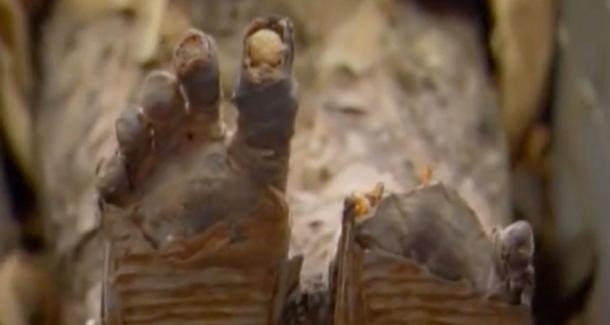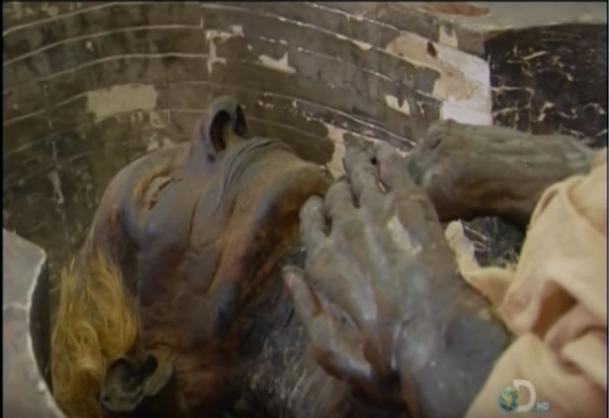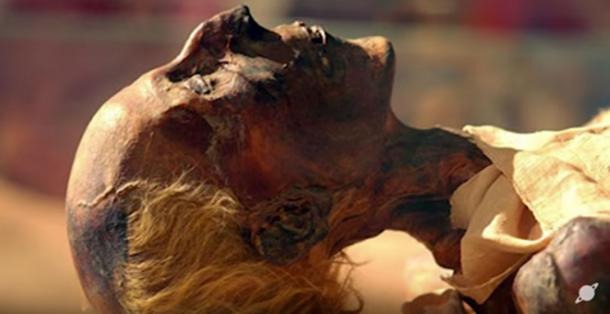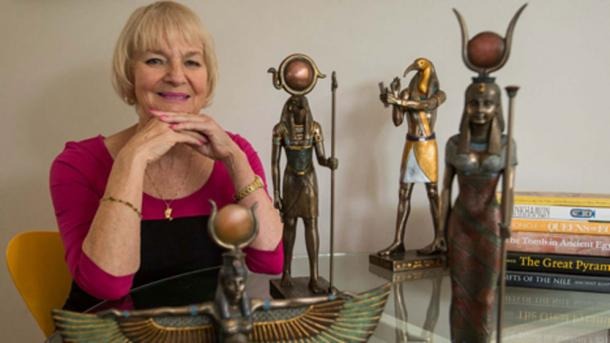Egyptian noblewoman Tjuyu and her husband Yuya were important figures in Amenhotep III’s court and she is believed to have died in 1375 BC. Most widely known as being the great-grandmother of legendary pharaoh Tutankhamun, her tomb was discovered in 1905 and a Channel 5 documentary The Nile: Egypt’s Great River , presented by British historian Bettany Hughes, has filmed a rare opening at the Egyptian Museum in Cairo.
The episode aired on Friday night and showed a team of Egyptologists carefully lifting the lid from Tjuyu’s tomb revealing what a Daily Star article called “her incredibly-well preserved body.” Bettany expounded “She’s so tiny and so perfect.” A 2016 Ancient Origins article describes Tjuyu as “the mother of Queen Tiye , a key women in the Theban court and it is thought that she might also be the “mother of the pharaoh Ay.” Thus, she would be Nefertiti and Mutnodjimet’s grandmother.
Colors of Death
On the show Egyptologist Salima Ikram explained that the cloths protruding from her eye sockets were made to look like eyes so that she could “see into the afterlife” and her body was so intact that it was even possible to see the sandals she was wearing while being mummified.

Tjuyu’s feet were remarkably preserved. (YouTube Screenshot)
Bettany noticed something strange about Tjuyu’s mummified corpse; rather than having dark brown hair, like the vast majority of other Ancient Egyptian mummies, she had “strawberry-blonde hair.” This somewhat bizarre phenomena was explained away by Egyptologist Ikram who said that it is unclear how her hair got to be this color, saying “We’re not 100% sure [if that is her original hair ].”
One of the reasons offered for the color of hair is the use of ‘natrons’ in the mummification processes . This naturally occurring mixture of ‘sodium carbonate decahydrate’, which was also an ancient household insecticide , was primarily used for making leather and to bleach clothing. This implies Tjuyu’s true hair color might have been deliberately lightened to give it a blonde-look or may have occurred accidentally through mummification.

Mummy of Yuyu also had blond hair. (YouTube Screenshot)
Blond Egyptians
In the last section when I referred to “the vast majority of other Ancient Egyptian mummies” having dark brown hair, well, I chose those words very carefully because according to Dr. Janet Davey from the Victorian Institute of Forensic Medicine in Australia, some ancient Egyptians were naturally blond and sometimes red haired .

Mummy of 19th dynasty King Rameses II with reddish-blond hair. (YouTube Screenshot)
An article recently published by The Sydney Morning Herald explains that most researchers claim different colors of the mummy hair resulted from the chemical interactions in the mummification process itself (natrons). However, Dr. Davey undertook a series of “innovative experiments” covering “16 hair samples from Egyptian people ” in the salty ash for 40 days. Guess what? Not a single change in hair color was observed.
Dr. Davey is convinced that there were fair-haired Egyptians but finding fair-haired mummies is “very rare” and this is why Egyptologists previously believed that lighter hair color was created during the mummification process. Davey suggests that these blond haired folk lived in Egypt during the Graeco-Roman Period (332 BC – 395 AD).

Dr. Davey’s experiments are claimed to prove that fair hair is was natural to some ancient Egyptians, such as Tjuyu. (YouTube Screenshot)
On December 14, 2014 Ancient Origins reported on a remarkable discovery in Fag el-Gamous necropolis, which lies along the eastern edge of the Fayum depression near Seila in Egypt. Dating to the time when the Roman or Byzantine Empire controlled Egypt, from the 1st to the 7th century AD, this enormous cemetery, believed to contain over one million burials, was excavated over three decades by archaeologists at Brigham Young University in Utah who among their discoveries unearthed “blond and redheaded mummies.”
Leave a Reply